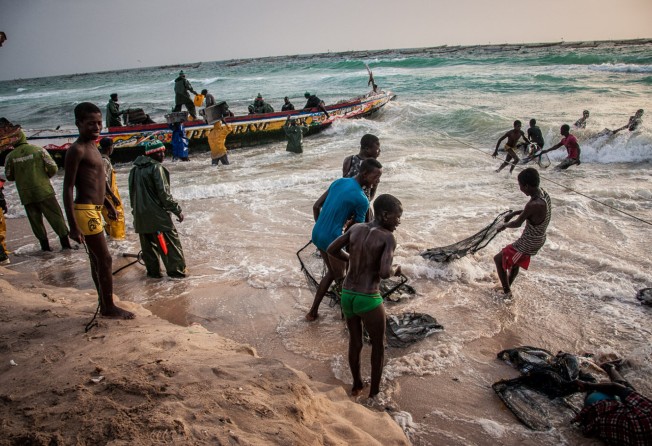China’s infrastructure loans are putting overseas marine habitats and locals at risk, study warns
- Researchers have ‘growing concerns’ about harm to marine habitats, local communities from Chinese investments
- Better oversight needed for China’s infrastructure lending to mitigate impacts on host countries, study says

Over the last decade, Chinese lenders have led an unprecedented overseas financing boom for an array of mega projects, including ports, power plants and roads under President Xi Jinping’s transcontinental infrastructure investment plan, the Belt and Road Initiative (BRI).
But all that investment appears to be coming with a growing environmental cost, according to researchers. A new study published by the journal One Earth has detailed the risks to marine systems from China’s global coastal development.
The findings suggest that some of those projects, especially ports and power plants, pose serious risks to marine biodiversity and indigenous communities in Africa and the Caribbean.
The study, released on Tuesday, said port developments presented the greatest dangers to marine systems, with power plants, roads and other facilities presenting the greatest risk factors.
Experts from the Boston University Global Development Policy Centre, the University of Queensland, University of California Santa Barbara, and Colorado State University, studied the marine risks of 114 coastal development projects financed by China from 2008 to 2019.
The projects in the study represented one-quarter of all projects financed by the China Development Bank and the Export-Import Bank of China. They totalled nearly US$65 billion in financing commitments.
The researchers said that most of China’s overseas development finance portfolio appears to have had negligible potential risks for marine systems, or at least lower risks than those considered in their study. However, they said it was likely that more coastal development projects have been financed, but have yet to be verified.
Most of the ports in the study that posed the biggest risks to marine ecosystems were in the Bahamas, Antigua and Barbuda, Cuba, Mauritania, Ivory Coast, Cameroon, Angola, Mozambique, Djibouti and Sri Lanka.
The only fishing port included in the study – the Beira Fishing Port Rehabilitation project in Mozambique – presented the single greatest risk to nearby marine habitats, compared to all other projects covered in the study, researchers said.
Coastal indigenous communities, particularly in West Africa, and the Caribbean, faced the greatest dangers, according to study, which noted that most development projects are located in areas that are densely populated.
The study identified 55 coastal indigenous communities whose nearby coastal waters were at risk from the negative impacts of development.
However, researchers said “this is likely a conservative estimate of the livelihoods that may be jeopardised from the loss of several marine ecosystem services, such as the provision of seafood or the income generated from artisanal fisheries and tourism”.
For example, several indigenous communities near development projects in Ivory Coast in Africa were estimated to consume more than 1,000 tonnes of seafood per year, yet the habitats they rely on faced some of the greatest ecological risks from development.
Researchers highlighted the Chinese-financed expansion of the Nouakchott Port in Mauritania – a deal that was completed without consulting nearby fishing villages – as an example that short-changed locals.

Rebecca Ray, one of the authors of the report, and a senior academic researcher at Boston University Global Development Policy Centre, said that as part of the port’s expansion deal, a government fishing concession agreement was signed with a Chinese fishing firm.
However, the scale of the operation had far out-competed smaller, local fishing businesses, leading to complaints of environmental and economic harm to the villages.
“The Mauritanian government points to the potential for job creation at the port, but if traditional livelihoods are lost, then these benefits could easily be diminished or even eliminated on net,” Ray said.
She said as China continued its development initiatives through ports and other coastal infrastructure, some coastal areas have seen greater environmental and social risks than others.
“Especially in the Caribbean and the Atlantic coast of Africa, our results show particularly acute risks to marine ecosystems and the communities that they support. Since these risks are highly concentrated within a few kilometres around the projects themselves, it is important, and feasible, for planners to place projects away from marine protected areas, likely critical habitats and indigenous-use seas,” Ray said.
The study said that risks to marine habitats are highest in Caribbean island nations, such as the Bahamas and Antigua and Barbuda, as well as western and central African coastlines.
According to the study, the countries that faced the smallest risks due to Chinese-financed development were Myanmar, Kenya and Liberia. Angola, Fiji, Sri Lanka and Indonesia collectively had more than 50,000 sq km (19,000 square miles) of marine habitats that faced low, but non-negligible risks from nearby projects, the study said.
Several other types of projects presented high impact risks to areas within 1km of the project site, such as power plants, bridges and roads. Impact risks declined rapidly, however, as distance from project sites increased, with most types of projects presenting relatively low risks beyond 10km (6 miles).
Together, the China Development Bank and the Export-Import Bank of China have lent more than US$460 billion to poorer countries since 2008 to build roads, power plants, ports, and other infrastructure. It is estimated that China is the world’s largest bilateral funder of overseas coastal infrastructure.
The study said the BRI, which includes the land-based “Silk Road Economic Belt” and the marine-based “21st Century Maritime Silk Road”, had enormous potential to propel economic prosperity in emerging markets, “yet there remain growing concerns over the potential deleterious impacts of this initiative on the environment and local and indigenous communities”.
The study said mitigating the risks will require more social and environmental safeguards, higher standards for host-country impact assessments, and greater integration of land-sea risk mitigation and management approaches.
It said with coastal populations expected to grow over the next three decades, “bluing” coastal development activities – the marine equivalent of “greening” land development – remains one of the major priorities for achieving some of the United Nation’s Sustainable Development Goals.
“Although China’s policy banks require that host countries provide pre-loan environmental impact assessments for review, there is no standardised approach for vetting these assessments against international best-practices,” the study said.
The researchers said the lack of unified standards can lead to rushed and insufficient impact assessments in countries with poor environmental governance, further undermining the guidelines of the Chinese lenders.
“China is well-positioned to extend its domestic environmental risk management policies to its overseas lending practices. China’s Ecological Conservation Redline policy, for example, has provided an important, data-driven framework for implementing ecosystem-based land use planning,” the study said.
The study was funded by the Climate and Land Use Alliance, the David and Lucile Packard Foundation, and the Rockefeller Brothers Fund.
